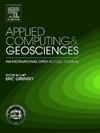利用深度学习超分辨率增强饱和流体裂缝特征预测
IF 3.2
Q2 COMPUTER SCIENCE, INTERDISCIPLINARY APPLICATIONS
引用次数: 0
摘要
地下资源的利用是实现能源可持续性的关键,包括大规模的二氧化碳封存、H2储存、地热能开采和碳氢化合物回收。地质介质中流体流动的现场可视化对于理解流体注入、储存和提取背后的复杂、耦合的物理和化学过程至关重要。在实验室中,x射线计算机断层扫描(CT)已被证明有利于可视化流场的变化,具有快速的时间分辨率(10 s)和中等的空间分辨率(100 μm)。在空间分辨率和时间分辨率之间存在权衡,这限制了对低于CT空间分辨率的岩石特征的准确动态表征。虽然过去的文献已经提供了提高CT岩石图像分辨率的解决方案,包括基于深度学习的算法,但我们的研究独特地专注于提高动态、部分和完全流体饱和的地质图像。流体饱和CT图像通过流体存在提供的增强信号提供额外的信息。在挑战中,地质介质的CT图像由于其单一通道灰度源而固有地具有有限的信息。此外,流体在部分饱和介质中的流动阻碍了现有的超分辨率技术,因为非饱和CT图像是饱和动态岩石图像的不准确代表。这项工作的新颖之处在于扩展了生成对抗网络(GAN),用于使用端元、不饱和高分辨率μCT图像来处理部分饱和低分辨率CT图像的超分辨率应用。为此,我们获得了非饱和和饱和状态下的多尺度低分辨率CT岩石图像。在GAN和卷积神经网络中,当使用各种饱和状态下的高分辨率图像、不饱和图像和低分辨率图像进行训练时,GAN可以产生逼真的高分辨率饱和地质介质重建。该模型对实时图像的判读具有直接的实用价值。本文章由计算机程序翻译,如有差异,请以英文原文为准。
Enhancing prediction of fluid-saturated fracture characteristics using deep learning super resolution
Utilization of subsurface resources is essential to achieve energy sustainability including large-scale CO sequestration, H storage, geothermal energy extraction, and hydrocarbon recovery. In-situ visualization of fluid flow in geological media is essential to understand complex, coupled, physical and chemical processes underlying fluid injection, storage, extraction. X-ray Computed Tomography (CT) in the laboratory has proven beneficial to visualize changes in the flow field with rapid temporal resolution (10’s s) and moderate spatial resolution (100’s ). There is a trade-off between spatial and temporal resolution that limits accurate characterization of dynamics in rock features that are below spatial resolution of CT. While past literature has offered solutions to improve resolution of CT rock images, including deep learning-based algorithms, our study uniquely focuses on improving dynamic, partially and fully fluid-saturated geological images. Fluid-saturated CT images offer additional information, through augmented signals provided by the presence of fluid. Among challenges, CT images of geological media inherently possess limited information due to their single-channel gray-scale source. Additionally, fluid flows through partially saturated media frustrate existing super resolution techniques because unsaturated CT images are an inaccurate proxy for saturated dynamic rock images. The novelty of this work is the expansion of a generative adversarial network (GAN) for applications involving super resolution of partially saturated low resolution CT images using end-member, unsaturated high resolution CT images. To this end, we acquired multiscale low- and high-resolution CT rock images in unsaturated and saturated states. Among GAN and convolutional neural networks, GAN’s produce realistic high-resolution reconstructions of saturated geological media when trained using high-resolution, unsaturated images and lower resolution images in various saturation states. The model has direct usefulness for interpretation of real-time images.
求助全文
通过发布文献求助,成功后即可免费获取论文全文。
去求助
来源期刊

Applied Computing and Geosciences
Computer Science-General Computer Science
CiteScore
5.50
自引率
0.00%
发文量
23
审稿时长
5 weeks
 求助内容:
求助内容: 应助结果提醒方式:
应助结果提醒方式:


